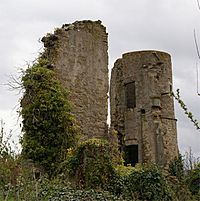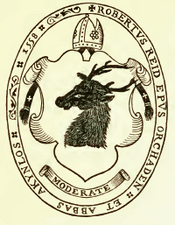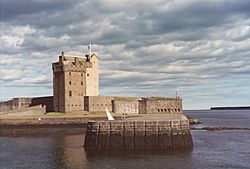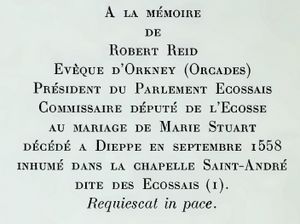Robert Reid (bishop) facts for kids
Quick facts for kids Robert Reid |
|
|---|---|
| Bishop of Orkney | |
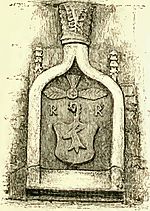
Coat of Arms of Robert Reid
|
|
| Church | Roman Catholic Church |
| Metropolis | St Andrews |
| Diocese | Orkney |
| Orders | |
| Ordination | c. 1519 (priest) |
| Consecration | 1529 (abbatial blessing) 1541 (bishop) |
| Personal details | |
| Born | c. 1496 – c. 1499 |
| Died | 6 September 1558 Dieppe, Normandy, France |
| Buried | Church of St Jacques, Dieppe in the Chapel of St Andrew |
| Nationality | Scottish |
| Parents | John Reid and Elizabeth (Bessata) Schanwell |
| Education | Master of Arts (1511 – 1515) Post graduate, prob. France (1515 – 1518) |
| Alma mater | St Salvator's College, St Andrews University |
| Motto | Moderate |
| Signature | |
Robert Reid (died 1558) was an important Scottish church leader. He served as the Abbot of Kinloss, the head of Beauly Priory, and later as the Bishop of Orkney. He was born in Aikenhead, Scotland, to John Reid and Elizabeth Schanwell.
Robert started his university studies in 1511 at St Andrews University. By 1524, he was a subdean at Elgin Cathedral. In 1526, he was chosen to become the Abbot of Kinloss. He traveled to meet the Pope in 1527. On his way back, he met a scholar named Giovanni Ferrerio in Paris, who later joined him in Scotland.
Robert Reid became Abbot in 1528 and also took charge of Beauly Priory in 1531. He held many important government jobs between 1532 and 1542. These included being an ambassador to England and France. He also made many improvements to the buildings of both Kinloss Abbey and Beauly Priory.
In 1541, King James V made Reid the Bishop of Orkney. After the King died in 1542, Robert Reid became involved in Scottish politics. He worked to protect Scotland's interests during a difficult time with England. He also served as a senior judge. Bishop Reid died in 1558 while returning from France. He had planned to establish a new college in Edinburgh.
Contents
Robert Reid's Early Life and Education
Robert Reid was likely born between 1496 and 1499. This is because he started university in 1511, and students usually began between ages 12 and 15. His parents were John Reid and Elizabeth Schanwell. Robert was the third of their six children. He had two older brothers, David and James, and three younger sisters, Christian, Helen, and Margaret.
Robert's uncle, Robert Schanwell, was an important person at St Andrews University. He was the Dean of the arts faculty. Robert Reid began his studies at St Salvator's College in St Andrews in 1511. He earned his Bachelor of Arts degree around 1513 or 1514. Then, on May 28, 1515, he received his Master of Arts degree.
After university, Robert Reid became a Notary public in 1518. This meant he could legally witness documents. By 1524, he was a subdean at Elgin Cathedral in the Diocese of Moray. By 1527, he became the "official" of the diocese. This role meant he was a lawyer and judge in the bishop's court. It required deep knowledge of church law and often civil law too.
Robert Reid as Abbot of Kinloss
Clement etc. to his dear son Robert Reid, Abbot of the Monastery of Kinloss, of the Cistercian Order, in the Diocese of Moray, greetings etc
...We appoint you abbot, and commit you to the cure, rule and administration of that same monastery, with full powers over its spiritual and temporal affairs.
Given at Viterbo, 4 July 1528, in the fifth year of Our pontificate.
Kinloss Abbey was founded in 1151, close to Elgin Cathedral. Abbot Thomas Crystall had led the abbey since 1500. He was very good at managing the abbey's money and property. He made sure the abbey's income doubled. Crystall also helped poor people and improved the abbey's buildings and library. He even increased the number of monks.
Thomas Crystall chose Robert Reid as his successor in 1526. In 1527, Reid traveled to meet Pope Clement VII. The Pope officially appointed Reid as the Abbot of Kinloss on July 4, 1528. This meant Reid had full power over the abbey's spiritual and financial matters. He received his blessing as Abbot in Edinburgh in the autumn of 1528.
One of Reid's first actions as Abbot was to get back lands that belonged to the abbey. He also turned the abbey's estates into a barony, which is a large area of land with special rights. In 1531, the scholar Giovanni Ferrerio came to Kinloss. He taught the monks there. Robert Reid also took charge of Beauly Priory in 1531. Ferrerio taught five monks from Beauly who came to Kinloss for three years.
Abbot Reid worked hard to improve the abbey. He renovated the abbot's rooms and built arches in the cloister. He also created a fire-proof library. Three chapels were decorated with altarpieces and murals. Outside, he had the abbey roof covered with lead. He also built new barns, a malthouse, and a dovecot.
Robert Reid as Bishop of Orkney
Paul etc. to his dear son Robert Reid, Elect of Orkney, greetings.
...We appoint you and prefer you to the office of bishop to the pastorate, cure, and administration of that church, and commit to you full powers in both spiritual and temporal matters.
Given at Rome, at Santa Maria [Maggiore], 16th October,1541, in the seventh year [of Our pontificate.]
After the Bishop of Orkney died in 1540, King James V nominated Robert Reid for the position in April 1541. The Pope officially granted him the bishopric on July 20, 1541. Reid was allowed to keep his other church roles, including being Abbot of Kinloss.
In 1544, Bishop Reid returned to his diocese in Kirkwall. He immediately started making big changes to the church buildings and how the diocese was run. He set up a new constitution for the diocese. This plan included seven main church officials, seven canons, thirteen chaplains, and six choristers. The chancellor was to give a weekly lecture on church law. One chaplain was put in charge of the grammar school.
St Magnus Cathedral in Kirkwall was owned by the town, not the church. A royal charter from 1486 said that money from a certain church income should be used for the cathedral's upkeep. However, Reid used other funds to pay for his changes. This meant money was taken from local parishes, which could affect the quality of care for people there.
As the leader of Beauly Priory, Reid had the bell-tower rebuilt in 1541 after a storm. He also renovated the main church and added oak tiles to the roof. More building work happened in 1544. Old priory buildings were torn down and completely rebuilt with many improvements. In Orkney, you can still see Reid's coat of arms on many buildings. This shows how much building he did. He restored the Bishop's Palace and added a round tower to it.
In 1554, Reid further organized the diocese. Chaplains and choristers were given new housing. The subdean received better rooms to help him keep order when the provost was away.
Robert Reid's Role in Diplomacy and Justice
The new College of Justice, Scotland's highest court, began in May 1532. Abbot Reid became a senator, replacing his uncle. He was also appointed to act as the president of the court when the main president was absent.
King James V sent Bishop Stewart and Abbot Reid to negotiate a peace treaty with King Henry VIII of England in 1533. The treaty was finally agreed upon in August 1534. A scholar later wrote that Reid and Stewart were the only ones who could achieve such a good peace with England. Reid also worked as a diplomat in France in 1535 and 1536. He helped arrange King James's marriage to French princesses.
Reid was an envoy to England again in 1541 and 1542. In 1542, he was stopped from returning to Scotland. This happened as England was preparing for war. King James V died in December 1542. James Hamilton, Earl of Arran, became regent for the young Queen Mary. Arran favored England and had Cardinal Beaton arrested.
In March 1543, Reid joined other nobles and churchmen who supported Beaton. They sent Reid to meet Arran. Reid asked for Beaton's release and for English New Testaments to stop circulating. Arran refused these requests. Despite opposing Arran's policies, Reid was chosen for the important Committee of the Articles in parliament. This committee helped decide what laws were passed.
Parliament approved the Treaty of Greenwich in 1543. This treaty planned for Queen Mary to marry Prince Edward of England. However, Arran changed his mind and rejected the treaty. This led to King Edward declaring war on Scotland. This eight-year conflict was known as the Rough Wooing.
Cardinal David Beaton was killed in May 1546. Arran then formed a small group of four politicians, including Reid, to advise him. Reid also helped find a doctor for Queen Mary and likely taught her about religion. After the death of the Lord President of the College of Justice in 1548, Reid was appointed to that role in February 1549.
In 1550, Reid worked to ensure that foreigners in Scotland spent their money on Scottish goods. From 1550 to 1552, he handled many legal and financial matters. In 1552, he was a commissioner to negotiate a peace treaty with England. This treaty aimed to end fighting, define the border, and arrange prisoner exchanges.
In April 1554, Mary of Guise, Queen Mary's mother, became regent. Reid, as Queen Mary's curator, presented documents to parliament for approval. His experience as an ambassador was needed again in 1557. He was one of the Scottish commissioners in Carlisle to discuss peace with England.
Robert Reid's Final Journey and Death
In October 1557, the King of France asked the Scottish parliament to send commissioners. Their task was to prepare for the wedding of Queen Mary to the Dauphin of France. Robert Reid was one of nine commissioners chosen for this important job.
On February 6, 1558, the day he left for France, Reid wrote his last will. He set aside 8,000 merks to create a college in Edinburgh. This college would have schools for grammar, arts, and law.
Reid sailed to France with other commissioners, their horses, and wedding gifts. The weather was bad. One ship carrying horses sank before leaving Scottish waters. Another ship was wrecked near the French coast, losing many people and valuable cargo. Reid and another commissioner, the Earl of Rothes, were shipwrecked near Boulogne. They were rescued by a French fishing boat.
On April 11, Bishop Reid and his fellow commissioners agreed on the marriage contract. This contract protected Scotland's rights. The French tried to get a separate agreement directly from Queen Mary that would harm Scotland, but the commissioners' contract stood. Mary's wedding took place on April 24 at Nôtre-Dame Cathedral.
A disagreement happened between the French council and the Scottish commissioners. The French demanded that the Honours of Scotland (the Scottish crown jewels) be sent to France. They wanted the Dauphin to be crowned King of Scotland. Reid and his fellow commissioners refused. They explained they had no permission from the Scottish parliament to agree to such terms.
The French king was unhappy. He prepared a letter to the regent in Scotland, asking her to persuade them. Two commissioners were sent to deliver this letter. The other commissioners, including Reid, were held back until the letter was delivered. Only then could Reid return to Scotland.
Reid arrived in Dieppe, France, at the end of August. He started his journey home but was forced back by a storm. By this time, the bishop and four other commissioners became very ill. They all died, with Reid being the first on September 6, 1558. He was buried in the Chapel of St Andrew in the Church of St Jacques in Dieppe.
Images for kids



